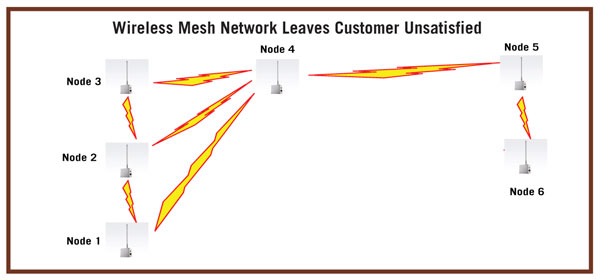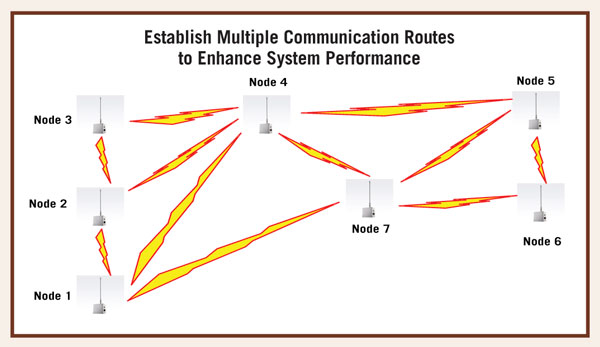Questions
- Which of the following are features of a well-designed wireless mesh network?
a. Self healing
b. Redundancy
c. Self configuring
d. All of the above
e. None of the above - Wireless mesh networks can support
a. video.
b. alarm monitoring
c. Web browsing
d. All of the above
e. None of the above - What type of agency listings have wireless systems received?
a. Household
b. Commercial Burglar Alarm
c. Commercial Fire
d. All of the above
e. None of the above - The range of a premises wireless
system can be extended by using
a. external antennas
b. repeaters
c. multiple receivers
d. Any of the above
e. None of the above - All fully supervised premises wireless systems are two-way.
a. True
b. False - A well-designed, premises wireless system should monitor
a. battery condition
b. status of device being monitored
c. condition of wireless device
d. All of the above
e. None of the above - Wireless mesh networks do not support VOIP service.
a. True
b. False - Spatial Diversity antenna systems are designed to overcome
a. range loss
b. nulls and dead spots
c. power requirements
d. Any of the above
e. None of the above - All wireless alarm transmitters use EOL loops.
a. True
b. False - Wireless mesh networks are useful
for temporary systems.
a. True
b. False - Which of the following can affect the range of a premises wireless system?
a. Construction materials
b. Furniture
c. Interior design selections
d. All of the above
e. None of the above - You must manually reconfigure a wireless mesh network when you add a node.
a. True
b. False - Wireless mesh networks can reduce installation costs.
a. True
b. False - Wireless alarm systems cannot provide wireless outputs.
a. True
b. False - What is the typical battery life for a premises wireless device?
a. 1 year
b. 1 to 3 years
c. More than 3 years
d. Any of the above
Answers
- d – These features make the network self administrating. If you add or move a node the system will automatically recognize it and reconfigure the network accordingly, and if a node or communication path fails data will automatically be rerouted around the problem.
- d
- d – There is wireless equipment available that meets the needs of virtually any CCTV, burglary or fire application.
- d – You should check with the manufacturer you use to determine which of these may be available.
- b
- d
- b – Wireless mesh networks can support any function that a traditional hardwired network can support.
- b
- b – Not all transmitters incorporate EOL supervision for all loops.
- a – Because they can be quickly deployed and do not require extensive wiring or trenching, wireless mesh networks are especially useful for temporary systems.
- d
- b – Most wireless mesh networks are self configuring, which allows them to automatically reconfigure the network when devices are added or moved.
- a – Although equipment costs may be higher, because there is very little wire running necessary, labor costs can be significantly lower compared to using a traditional hardwired approach.
- b
- d – The life expectancy of a battery depends upon many factors such as power used, frequency, battery type and how often it transmits. You should check with the manufacturer you use to determine the projected battery life for your systems.

What’s Wrong With This?
Wally ‘Larman was asked to install a redundant wireless mesh network-based video and security system for a local industrial park. Wally selected equipment that had sufficient bandwidth for the applications and installed the nodes that had reliable communication paths as shown in this diagram. When Wally tested the system everything functioned as he expected, but the client was not satisfied with the system’s performance. Can you see what Wally did wrong and what he must do to correct the problem?

Answer to: What's Wrong With This?
Wally’s problem is caused by a lack of redundancy in the links. If the communication path between node 4 and 5 fails or if node 5 fails, both nodes 5 and 6 will lose communication. Wally should add a new node that establishes another path, such as shown in this diagram. This way a single fault will not affect anything else in the network, since the mesh network will automatically reroute data around the fault. It should be noted that in a typical mesh network nodes can effectively communicate with multiple other nodes so that redundancy is further enhanced.




